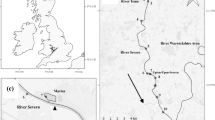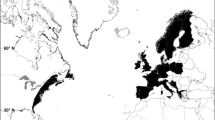Abstract
On the basis of large collections, comprehensive data on the distribution of larvae of three species of flatfishes of the genus Bothus (B. ocellatus, B. robinsi, and B. podas) in the northern Atlantic are provided, and the routes of their drift migrations are discussed. Special attention is focused on discussing problems of identification of larvae of the listed species and the specification of evidence on meristic characters of adult flatfishes of these species used for the diagnostics of their larvae. It is shown that larvae of two American species of Bothus carried out from the shelves to the system of western boundary currents are widely distributed in the northern Atlantic drifting in waters of the Northern Subtropical Gyre (NSG). Some of them reach the Azores, and some are drifted along the periphery of the circulation system of the NSG currents towards North America. Unlike larvae of American species, larvae of the eastern Atlantic B. podas perform no transatlantic drift migrations, and the area of their distribution is confined to the waters of the eastern Atlantic. Such differences in the extent of latitudinal passive migrations between B. podas and western Atlantic species are explained according to Torson (1965) by differences in temperature conditions during the drift of larvae of species under comparison that directly affect the decrease (during water temperature increase) or increase (at temperature decrease) of the pelagic phase in their development. The latitudinal drift of larval B. podas from West Africa westwards proceeds due to currents that gradually warm during their motion, which causes a decrease of the dates of their staying in the pelagial. The transatlantic drift of larval American Bothus spp. from North America eastwards is observed in gradually cooling currents, which leads to an increase in the duration and extent of their passive migrations.
Similar content being viewed by others
References
Y. Aldebert, M. Desoutter, and J. C. Quero, “Bothidae,” in Check-List of the Fishes of the Eastern Tropical Atlantic (CLOFETA). JNICT. Lisbon, SEI., Ed. by J.C. Quero, J.C. Hureau, C. Karrer, et al. (UNESCO, Paris, 1990), Vol. 2, pp. 1027–1036.
E. I. Baranov, “Dynamics and Structure of Waters of the Frontal Zone of the Gulf Stream,” Okeanol. Issled, No. 22, 93–153 (1971).
F. H. Berry, “Young Jack Crevalles (Caranx Species) off the South Eastern Atlantic Coast of the United States,” Fish. Bull. 59, 417–535 (1959).
C. M. Breder, “Special Features of Visibility Reduction in Flatfishes,” Zoologica 40,Parts 2. 8, 91–98 (1955).
V. V. Burkov, M. N. Koshlyakov, and V. N. Stepanov, “General Data on the World Ocean,” in Oceanology. Physics of the Ocean, Vol. 1: Hydrophysics of the Ocean, Ed. by V.M. Kamenkovich and A.S. Monin (Nauka, Moscow, 1978), pp. 11–84.
Catalog of Fishes, Ed. by W.N. Eschmeyer (Spec. Publ. Center for Biodiversity Research Information. CAS, San Francisco, CA, 1998).
J. B. Colton, “The Distribution of Eyed Flounder and Lantern Fish Larvae in the Georges Bank Area,” Copeia, No. 3, 274–279 (1961).
G. Dietrich and J. Ulrich, Atlas zur Ozeanographie (Bibliographisches Institut Mannheim, 1968), pp. 1–76.
S. A. Evseenko, “Larvae of Bothus ocellatus (Agassiz) from the Northwestern Atlantic,” Vopr. Ikhtiol. 16(4)99), 661–669 (1976).
S. A. Evseenko, “Some Data on Metamorphosis of Larvae of the Genus Bothus from the Caribbean Sea,” Zool. Zh. 57(7), 1040–1047 (1978).
S. A. Evseenko, “Ecologo-Morphological Specific Features of Early Stages of Development of Flatfish from the Western Part of the Northern Atlantic,” Tr. Inst. Okeanol. Ross. Akad. Nauk SSSR 118, 43–84 (1982).
S. A. Evseenko, “Ichthyoplankton of Slope and Gulf Stream Waters off Nova Scotia in Late Autumn 1974,” J. Northwest Atlant. Fish. Sci., No. 3, 127–139 (1982).
S. A. Evseenko, “On Finding a Citharichthys sp. Larva (Paralichthyidae, Pleuronectiformes) off the Azores,” Vopr. Ikhtiol. 39(5), 711–714 (1999) [J. Ichthyol. 39 (8), 682–685 (1999)].
S. A. Evseenko, “Family Achiropsettidae and Its Position in the Taxonomic and Ecological Classifications of Pleuronectiformes,” J. Ichthyol. 40(Suppl. 1), S110–S138 (2000).
S. A. Evseenko, “Early Life History Stages of Peacock Flounder Bothus lunatus (Bothidae) from the Western and Central Tropical Atlantic,” Vopr. Ikhtiol. 48(4), 517–527 (2008) [J. Ichthyol. 48 (7), 515–524 (2008)].
S. A. Evseenko and E. V. Nadtoka, “On the Identification of Flatfish Larvae of Two Closely Related Species of the Genus Bothus (Bothidae) from the Western Atlantic,” Vopr. Ikhtiol. 43(4), 572–574 (2003) [J. Ichthyol. 43 (7), 551–553 (2003)].
M. P. Fahay, “An Annotated List of Larval and Juvenile Fishes Captured with Surface-Towered Meter Net in the South Atlantic Bight during Four R/V Cruises between May 1967 and February 1968,” NOAA Tech. Rep. NMFS SSRF 685, (1975).
G. R. Flierl and J. S. Wroblewski, “The Possible Influence of Warm Core Gulf Stream Rings Upon Shelf Water Larval Distribution,” Fish. Bull. 83, 313–329 (1985).
F. C. Fuglister, “Cyclonic Rings Formed by the Gulf Stream 1965–1966,” Coll. Rep. Woods Hole Oceanogr. Inst., Part 1, No. 2489, 137–168 (1972).
A. Gordon, “Sargasso Sea,” in Oceanographical Encyclopedia (Gidrometeoizdat, Leningrad, 1974), pp. 440–441.
E. J. Gutherz, “Field Guide to the Flatfishes of the Family Bothidae in the Western North Atlantic,” U.S. Dept. Interior, Fish Wildl. Serv. Bur. Comm. Fish. Circ., No. 263 (1967).
T. V. Jutare, Studies on the Biology of Bothus ocellatus with a Description of a Related New Species, M.S. Thesis, Miami Univ., 1962.
S. C. Kempf, “Long-Lived Larvae of the Gastropod Aplysia juliana: Do They Disperse and Metamorphose Or Just Slowly Fade Away?,” Mar. Ecol. Progr. Ser. 6, 61–65 (1981).
G. Klein-MacPhee, “Lefteye Flounders. Family Bothidae, pp. 546–54”, in Bigelow and Schroeder’s Fishes of the Gulf of Maine, Ed. by B.B. Collette and G. Klein-MacPhee, 3rd ed. (2002).
H. M. Kyle, “Flat-Fishes (Heterosomata),” Rep. Dan. Oceanogr. Exp. Mediterr. 2(A1), 1–150 (1913).
M. R. Lara, “Chapter 203. Bothidae: Lefteye Flounders),” in Early Stages of Atlantic Fishes: An Identification Guide for Western Central North Atlantic, Ed. by W.J. Richards (CRC Taylor Francis Group, 2006), Vol. 2, pp. 2327–2343.
D. Laursen, “Taxonomy and Distribution of Teleplanic Prosobranch Larvae in the North Atlantic,” Dana-Rep., No. 89 (1981).
J. M. Leis, “Coral Reef Fish Larvae (Labridae) in the East Pacific Barrier,” Copeia, No. 3, 826–828 (1983).
R. Lumpkin and S. L. Garzoli, “Near-Surface Circulation in the Tropical Atlantic Ocean,” Deep-Sea Res. 52(3) Part 1, 495–518 (2005).
D. F. Markle, W. B. Scott, and A. C. Kohler, “New and Rare Records of Canadian Fishes and the Influence of Hydrography on Resident and Nonresident Scotian Shelf Ichthyofauna,” Can. J. Fish. Aquat. Sci. 37, 49–65 (1980).
J. L. Munro, V. C. Gaut, R. Thompson, and P. H. Reeson, “The Spawning Season of Carribean Reef Fishes,” J. Fish. Biol. 5, 69–84 (1973).
J. T. Nichols, “A List of Turk Islands Fishes, with a Description of a New Flatfish,” Bull. Am. Mus. Nat. Hist XLIV, 21–24 (1921).
J. Nielsen, “Psettodoidea and Pleuronectoidea (Pisces, Heterosomata),” Atlantide Rept, No. 6, 101–127 (1961).
J. Nielsen, “Bothidae,” in Fishes of the North-Eastern Atlantic and the Mediteranean, Ed. by P.J.P. Whitehead et al. (1986), Vol. 3, pp. 1294–1298.
J. R. Norman, A Systematic Monograph of the Flatfish (Heterosomata), Vol. 1: Psettodidae, Bothidae, Pleuronectidae (Brit. Mus. London, 1934).
T. Ozawa and A. Fukui, “Studies on the Development and Distribution of the Bothid Larvae in the Western North Pacific,” in Studies on the Oceanic Ichthyoplankton in the Western North Pacific, Ed. by T. Ozawa (Fukuoka: Kyushu Univ., Fukuoka, 1986), pp. 322–420.
N. V. Parin, Ichthyofauna of the Oceanic Epipelagial (Nauka, Moscow, 1968) [in Russian].
C. Parker, “Gulf Stream Rings in the Sargasso Sea,” Deep-Sea Res. 18(10), 981–993 (1971).
R. Robertson, “Dispersal and Wastege of Larval Philippia krebsii (Gastropoda: Architectonicidae) in the North Atlantic,” Proc. Acad. Nat. Sci. Philad. 116(1), 1–27 (1964).
R. S. Santos, F. M. Porteiro, and J. P. Barreiros, “Marine Fishes of the Azores: An Annotated Checklist and Bibliography,” Arquipélago. Life Mar. Sci Suppl. 1 Ponta Delgada (1997).
R. S. Scheltema, “Evidence for Trans-Atlantic Transport of Gastropod Larvae Belonging to the Genus Cymatium,” Deep-Sea Res. 13, 83–95 (1966).
R. S. Scheltema, “Larval Dispersal As a Means of Genetic Exchange Between Geographically Separated Populations of Shallow-Water Benthic Marine Gastropods,” Biol. Bull. Mar. Biol. Lab. Woods Hole 140(2), 284–322 (1971).
J. Schmidt, Introduction to the Oceanographical Reports. The Danish “Dana”-Expeditions 1920–22 (Copenhagen, 1929).
W. G. Smith, J. D. Sibunka, and A. Wells, “Seasonal Distribution of Larval Flatfishes (Pleuronectiformes) on the Continental Shelf Between Cape Code, Massachusetts, and Cape Lookout, North Carolina, 1965–66,” NOAA Techn. Rep. NMFS SSRF-691 (1975).
A. Stauch, “Quelques données sur les Bothus de l’Atlantique et description d’une espéce nouvelle Bothus guibei n. sp. (Pisces, Teleostei, Heterosomata),” Bull. Mus. Nat. d’Hist. Natur. 38(2), 118–125 (1966).
A. V. Tåning, “List of Supplementary Pelagic Stations in the Pacific Ocean and the Atlantic,” Dana-Rep., No. 26, 1–15 (1944).
R. W. Topp and F. H. Hoff, “Flatfishes (Pleuronectiformes),” Mem. Hourglass Cruises 4Part 2, 1–135 (1972)
G. Thorson, “Prodolzhitel’nost’ zhizni lichinok donnykh bespozvonochnykh v pelagicheskoi planktonnoi srede v svyazi s perenosom ikh okeanicheskimi techeniyami,” Okeanografiya, Ed. M. Sirs, Moscow: Progress, 356–371 (1965) [Tr. of: G. Thorson, “Length of Pelagic Larval Life in Marine Bottom Invertebrates as Related to Larval Transport by Oceanic Currents,” Oceanography, Amer. Ass. Advmt. Sci., vol. 67, pp. 455–474 (1961)].
J. S. Wroblewski and J. Cheney, “Ichthyoplankton Associated with a Warm Core Ring off the Scotian Shelf,” Can. J. Fish. Aquat. Sci. 41, 294–302 (1984).
Author information
Authors and Affiliations
Corresponding author
Additional information
Original Russian Text © S.A. Evseenko, 2008, published in Voprosy Ikhtiologii, 2008, Vol. 48, No. 6, pp. 825–843.
Rights and permissions
About this article
Cite this article
Evseenko, S.A. Distribution and routes of drift migrations in larvae of three species of flatfish Bothus (Bothidae) in open waters of the northern Atlantic. J. Ichthyol. 48, 792–809 (2008). https://doi.org/10.1134/S0032945208090105
Received:
Published:
Issue Date:
DOI: https://doi.org/10.1134/S0032945208090105




